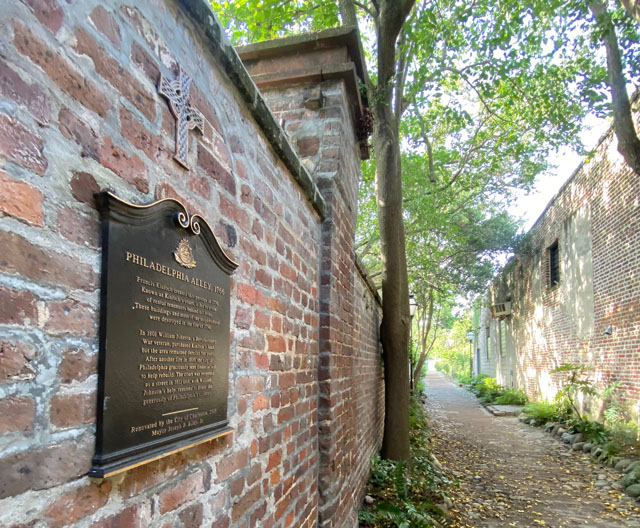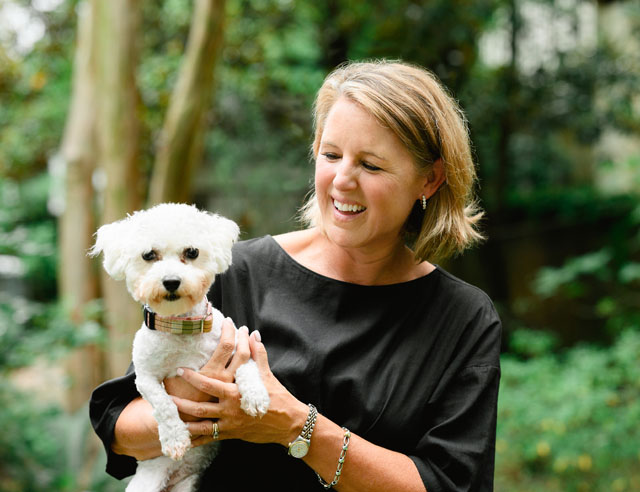Settling Scores on Philadelphia Alley
06 Sep 2023
The lore and legend of duels along a Charleston corridor
By Tim Lowry
Photos by Jenny Peterson

Running from Cumberland Street to Queen Street and parallel to Church Street, practically in the shadow of the great steeple of St. Philip’s Anglican Church, is a narrow pedestrian thoroughfare known to Charleston locals as Philadelphia Alley.
Visitors to the Holy City often pass right by this quiet lane as they hurry on to more well-known landmarks like Rainbow Row or The Battery. However, one should never judge a book by its cover. Even though Philadelphia Alley is not pictured on thousands of Charleston postcards, it is nonetheless a storied street. The area was originally known as Kinloch Court and was sometimes referred to as Cow Alley, probably because cattle were driven down the narrow path on their way to the beef market that was once located on the corner of Broad and Meeting Streets, where City Hall now stands as one of the pillars of the fabled “Four Corners of Law.”
Kinloch Court was the address of several tenement houses. Eventually the court (what most folks would call a “dead end street”) was eventually widened and opened on both ends and officially named Philadelphia Street. The reason for the name change is not entirely clear, but there is evidence that the name was in honor of the people of Philadelphia, PA. The City of Charleston suffered a devastating fire in that general area in the year 1796 and the people of Philadelphia having a kinship with Charleston since the days of the American Revolution, sent financial contributions to help with the rebuilding. Charlestonians reciprocated with aid and relief when their northern friends suffered a yellow fever epidemic just a couple years later in 1798. Then another fire struck the area around Kinloch Court in 1810, and the leaders of Philadelphia were quoted as saying they wanted to be “the first if not the most generous contributors” in helping with another rebuilding effort and donated to the City of Charleston $8,000 for recovery efforts. It was not stated in official city records, but has largely been assumed that the name Philadelphia Street (eventually changed to Alley) was in recognition of the brotherly love between the two cities. Ironically, the quiet and out-of-the-way location would become known as a place for sword and pistol duels in the settling of scores between feuding gentlemen.
Many of the stories associated with Philadelphia Alley are not well documented. But nonetheless, they persist in local lore and legend. Dueling was a prominent practice from Charleston’s founding in 1670 until the latter half of the 19th century. Today, the practice seems ludicrous, but in previous times the gentlemen’s duel was socially acceptable as a well-planned and carefully executed ritual that followed a particular code of ethics, largely seen as the final solution for defending one’s honor or answering a slanderous or libelous claim.
Though publicly condemned by civic leaders and military officers, the practice was all too common in Charleston. There are several examples of published accounts in local newspapers. Of particular note is a notice from May 25, 1839: “Duel fought at the lower end of Broad Street between Fell and Herriot, the former shot in the foot to keep him from running and the latter in the mouth (to) keep him from jawing.” It is said that more than twenty duels were fought in Philadelphia Alley. Many of these stories may simply be the exaggerated tales of tour guides. However, there are two accounts that have persisted as part of Charleston’s history. The details are sketchy, but the stories have been repeated often enough that Charlestonians tell them as truth. The first was printed as a historical piece in an 1894 edition of the New York Times. Cow Alley (Philadelphia Street) was “remembered as the scene of a duel one bright Sunday morning, when Gen. William Moultrie ‘pinked his man in beauty’s quarrel.’” Apparently, General Moultrie had a particular grievance with an unidentified gentleman. Upon meeting his rival at the corner of Queen and Church Streets, he proposed that they settle the score by drawing short swords, which were part of every well-dressed gentleman’s outfit. Stepping into the alley and away from public view, the gentlemen drew their weapons and began a person-to-person combat in which several passes were made until General Moultrie succeeded in running his sword through his opponent’s arm. Satisfied, General Moultrie withdrew his weapon, wiped away the blood, saluted his rival and then walked down the street to attend holy services at St. Philip’s Church.
The second story concerns Dr. Joseph Brown Ladd and his rival, Ralph Isaacs III. The young doctor was originally from Rhode Island. Because of an unfortunate set of circumstances involving unrequited love, he had relocated to Charleston where he rented lodgings from the Rose Sisters at 59 Church Street. The “spinster” sisters reported that he often absent-mindedly whistled tunes as he moved about the house. The whistling doctor was somewhat of a poet and apparently was quite charming with the ladies. Eventually, the popularity of this Yankee newcomer made his friend, Ralph Isaacs III, rather jealous. They had an argument. Some versions of the story say it was over a local actress.
To put it into the words of my grandfather, “They talked about honor and valor and stuff, but that was basically an excuse to try and kill each other. All of those duels were over some woman.”
At any rate, the quarrel ended with a pistol contest supposedly fought in Philadelphia Alley in which Dr. Ladd purposefully aimed high to avoid injuring his friend. However, Ralph Isaacs III shot Dr. Joseph Brown Ladd in the leg. Dr. Brown was carried back to his lodgings at 59 Church Street where he died some days later from infection. It is said that on quiet nights you can still hear his whistling both at 59 Church and in the shadowy, narrow lane that was the location of the fatal duel. Perhaps the story is just a story. Nonetheless, the historical marker at 59 Church is the only one in the city to note the presence of a ghost in a historic home.
Storyteller Tim Lowry is a Southern raconteur from Summerville. Learn more at www.storytellertimlowry.com.












